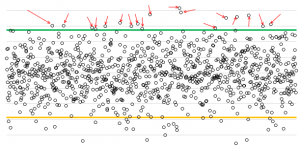What’s that? Another SEP Blog Battle you say? Of course I’ll chime in!
What’s that? The first topic I’ve got is Positive Deviance? Ok…
What the heck is Positive Deviance?
Well, what do I think it is based on that statistics course I took 15 years ago, and based on more recent dealings with tracking project metrics? My first thought… that sounds like if I’m looking at a trend, I’m interested in the data points that are outliers on the positive side of the normal distribution.
But then what? Surely there is there more to it than that?
Hey! Maybe this Positive Deviance concept is a “thing”. Oh! So that is why I’m capitalizing those words outside the title of the blog. What does the internet have to say about Positive Deviance?
- Wikipedia article on Positive Deviance
- Q&A on Positive Deviance by Ben Ramalingam
- Harvard Business Review IdeaCast with Richard Pascale
Ah-hah! So Positive Deviance is something specific after all. On the surface, it sounds a bit like determining best practices. However…
Positive Deviance differs from best practices.
And it does so in some pretty significant ways:
The community has to decide that there is a problem to be solved.
- This can’t be something that is mandated from on high.
- The community has to care enough to search for solutions.
The problem you’re targeting is “tough”.
- The problem is likely thought of as impossible or hopeless. There have probably been many attempts to solve the problem already with little or no success. If you’ve already got a solution that can be shown to work, then there is no need to use a PD approach.
- The problem likely has some social or behavioural aspect. If you’ve got a problem that is purely technical, you probably won’t need PD to solve it.
You start with a community that has roughly the same resources.
- What you are trying to determine is what differences are leading to individuals succeeding where most fail (those succeeding individuals are the Positive Deviants).
- This differs from most best practices discussions as they tend to focus on any and all success stories, without regard of their starting point.
The solution is very targeted to the community.
- What works for one community may not work for another community.
- Outside experts may be a hindrance rather than a help.
- The community likely needs to define itself (rather than being defined by outsiders).
So… now that we have an idea got that out of the way, what do I think?
So do we use Positive Deviance at SEP?
At first, my opinion was “oh, we’ve done that, we just didn’t know there was a name for it” (similar to how we started doing many agile practices before we knew about “Agile”). Sure, we could almost certainly do it better by learning about it more, but it sounds like we’ve done the basics, right?
But then I got to thinking about it a bit more, and while we’ve had some great things accomplished by grassroots efforts (my favorite examples always being our book clubs and internal startup weekends), I’m not so sure I can actually point to a case where we’ve really used Positive Deviance. What pieces have we been missing in my opinion?
- Getting the community to search for the answer – Based on what I’ve come across, it feels like the intent is that the whole community takes part. While we definitely have a lot of examples of changes coming from the community, it seems like more often than not this is the case of one or two people deciding to try something out and proposing it to the larger group.
- Taking a hard look at data – It seems like actually having data in hand and using it to help find the Positive Deviants and then using data to determine where the differences are at is part of the process. But most/all of the cases that were coming to my mind as possible examples of PD at SEP seem to be cases where we relied on anecdotes more than data.
- Focusing on why the Positive Deviance are succeeding in the face of failure – More often than not, it seems we tend to approach things from the aspect of “Why is this large group of things overall not working? Let’s fix it by tackling the biggest failures first.” rather than “Hey, out of this large group that is failing overall, there is this small group that is succeeding. What makes them different?”
But, I honestly don’t know whether any of those issues I just raised are really problems (that “disqualify” us from saying we’ve used PD) or if they are just things we should consider in order to improve the next time we want to tackle a tough problem. It is also entirely possible that I’ve overlooked some good examples of where we have used PD at SEP (in which case hopefully someone will chime in).
One thing I do know for sure. I want to know more about this. I plan to start with The Power of Positive Deviance by Richard Pascale.